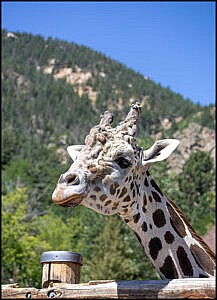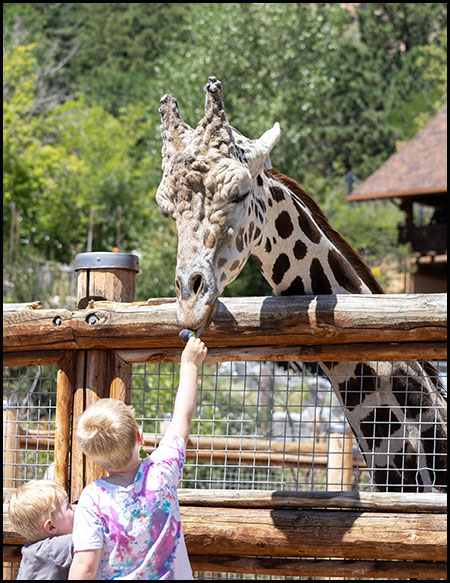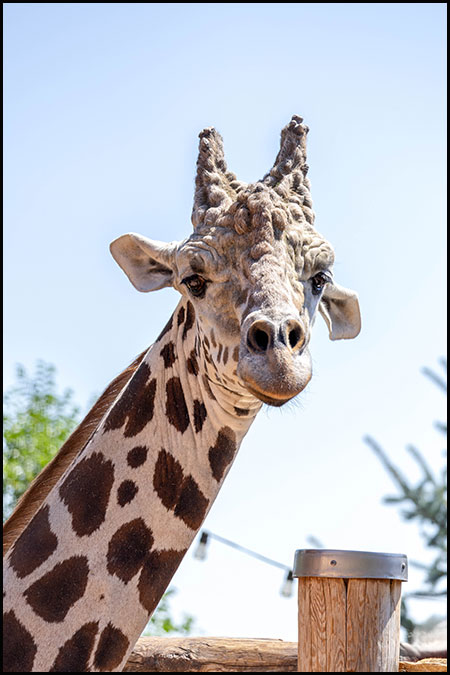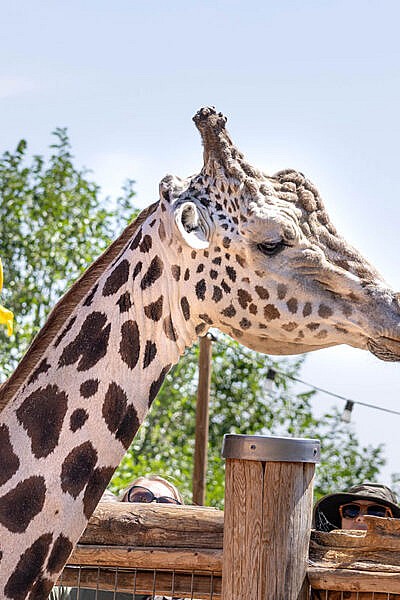Khalid, CMZoo’s 16-year-old breeding bull giraffe, may be considered aging for an intact male giraffe in human care. But, at 16, he’s tackling new training routines and locations with the enthusiasm, confidence and consistency of a much younger giraffe.

The trusting relationships he has built with his keepers, along with the confidence he has in his environment, set him up for success as he and his keepers adjust his care plan to address issues into his golden years. Recently, Khalid has been experiencing some discomfort, particularly when standing on certain surfaces or at specific angles. Keepers have noticed him shifting his weight unusually and being less interested in participating in hoof care.
“We know him really well, so we can pick up on his subtle ways of communicating that he’s not confident in a certain space, even if he previously has been,” says Kelsey Newman, senior animal keeper in African Rift Valley. “We can also tell if he’s walking slightly differently, or if we need to brainstorm new ways to train with him so he’s more comfortable.”
Shortly after Khalid came to CMZoo, his team recognized a kink in his neck that his team addressed by training him to voluntarily stretch his neck when asked. He also received chiropractic care and laser therapy for his neck. He still participates in neck stretches, and his team keeps that history in mind while adjusting his routine as he ages.
Most giraffe in the CMZoo herd participate in hoof care in a barn stall where keepers are standing on the same floor as the giraffe. In that space, the giraffe walk up to a giraffe-chest-high fire hose connected to two metal doors. The hose prevents the giraffe from entering space with humans, for safety reasons. The open metal doors allow the giraffe to lift one front foot up and place it on a resting block, where keepers can trim hooves or address other issues.
Khalid has participated in voluntary hoof care sessions for many years, but the amount of time he was willing to participate in those sessions became shorter over time. His care team discussed elements in the training area that could be distracting him, or whether they needed to ask him to participate more or less frequently, or if he was physically uncomfortable during sessions.

“When we’re standing on the ground, and he gets a reward for training, we ask him to lean his big body forward to lower his head to get his treat from our hand,” Kelsey says. “You can see how if your front feet were already tender, leaning forward on one of those front feet would make you feel a little unsure. He told us he didn’t feel confident doing that by slowly taking a step back and looking at us as if to say, ‘I’ll do something else if you want, but I don’t like that one.’”
Rather than pushing through, they invited Khalid to participate in his familiar training routine in a different location known as ‘the chute,’ at the back of the giraffe barn. The chute has a platform, so keepers can get face-to-face with giraffe. The chute also has metal barriers on either side, so keepers are safe up high and down by his giant feet, but Khalid can still exit the training whenever he wants. Two sets of keepers work with Khalid at the chute. Two keepers work on his feet while two are up high on the platform, reinforcing his good behaviors without having to ask him to bend down.
Thanks to this tailored setup for Khalid, he participates in hoof trims more often, which is making his hooves and legs more comfortable. He also receives oral pain and anti-inflammatory medications, delivered on his favorite honey-and-lettuce roll-up.
“I keep joking that he prefers the setup in the chute because he has the full attention of four keepers, instead of just two,” Kelsey says. “He’s a giant sweetheart. Sometimes he asks for face scratches from certain people, and I’m honored to say I’m one of them. He’ll put his giant face into your torso and lean in for a good scratch. It’s the best.”
Speaking of faces, Khalid’s is unlike any other at the Zoo. Many visitors ask if Khalid’s face is so bumpy, compared to the rest of the giraffe, because he’s old. But the bumps on Khalid’s face are natural calcium deposits that form as testosterone-producing males reach maturity. The adaptation developed to protect males competing for territory in the wild.
During battle, male giraffe use their heads, and more specifically, they use their ossicones. They swing their heads with incredible force thanks to their long, muscly necks, right into their opponents. To protect their eyes and brains from the offensive impact, they grow thick ‘helmets’ around their ossicones and heads.
In addition to hoof care, medication and a good dose of face scratches from his keepers, Khalid’s care plan includes lots of movement. Although Khalid prefers not to explore the big yard (he’s been offered the chance many times, and consistently chooses not to go into that space), he explores a series of connected spaces and outdoor yards, set up with environmental enrichment that encourages him to take long strides and keep those big legs moving.

One surefire way to get Khalid moving is to invite him anywhere near Bailey, his most recent breeding partner in the herd. Bailey and Khalid are parents to 2-year-old BB, who recently moved to Denver Zoo Conservation Alliance, and 1-year-old Wednesday, who still lives with the herd.
As a breeding bull, Khalid has helped bring seven giraffe calves into the world, also including 5-year-old Viv, who still lives at CMZoo. When calves are born, Khalid quietly observes from another stall. When the opportunity is right, he usually reaches over the stall fence to give his new calf a good sniff, and usually a big lick on the head.
“Khalid is an icon here at the Zoo, and he does so much for his species, both by inspiring countless people to care for giraffe, and by contributing to the population in human care,” Kelsey says. “We’re going to do everything we can to help Khalid step into his golden years with dignity and comfort, because we want him to be able to continue his work in both of those departments.”
Visitors can see Khalid, and hand-feed him lettuce, in the side yard or barn in African Rift Valley. Exciting improvements are underway at CMZoo! This means normal routes to guests’ favorite animals may be different, but visitors can still see all animals at the Zoo! Watch for signs for alternate routes.

